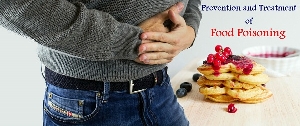Health News of Tuesday, 12 March 2024
Source: Dr Pet-Paul Wepeba, Contributor
From accidental to intentional: Distinguishing between food poisoning and poisoned food
As incidents of foodborne illnesses and intentional food poisoning continue to make headlines, concerns about food safety and security have become paramount.
Numerous cases exist in antiquity, including but not limited to the Aqua Tofana Poisonings (17th century) in Italy, the Michigan Wine Tampering Incident (1973). the Burger King Poisonings (1997), the Tylenol Murders (1982), all in the USA and the Tainted Medicine Incident in Haiti (2019).
Individual cases include Alexander Litvinenko (2006), a former Russian intelligence officer turned whistleblower, died in London after being poisoned with a lethal dose of radioactive polonium-210. Viktor Yushchenko (2004), a Ukrainian politician and later President of Ukraine, fell seriously ill during his presidential campaign in 2004 after consuming food or drink contaminated with dioxin, a highly toxic chemical.
In this article, we explore the nuances between accidental contamination and deliberate tampering of food, highlighting the challenges and implications for public health and safety.
Accidental contamination of food occurs when harmful microorganisms, chemicals, or foreign objects inadvertently enter the food supply chain during production, processing, handling, or storage. Common sources of accidental contamination include improper food handling practices, inadequate sanitation, cross-contamination, and equipment malfunctions. Deliberate tampering of food involves the intentional introduction of harmful substances or foreign objects into food or beverages with the intent to harm, deceive, or sabotage. Motives for deliberate tampering may vary, including extortion, terrorism, revenge, or product tampering for financial gain or competitive advantage.
In the realm of public health and forensic investigations, distinguishing between food poisoning and poisoning of food is crucial for effective response, treatment, and justice. While both encompass harmful substances entering the body through food, they differ significantly in their causative agents, symptoms, and investigative processes.
Causative Agents: Food poisoning typically occurs due to the consumption of contaminated food or beverages. The contamination may arise from various sources, including bacteria (such as Salmonella, E. coli, and Listeria), viruses (like norovirus and hepatitis A), parasites, toxins produced by bacteria (such as Staphylococcus aureus and Clostridium botulinum), and chemical contaminants (such as pesticides and heavy metals).
In contrast, poisoning of food involves the deliberate introduction of harmful substances into food or beverages with the intent to cause harm or death. These substances may include toxic chemicals (such as cyanide or arsenic), drugs (such as opioids or benzodiazepines), or other poisonous compounds.
Symptoms: The symptoms of food poisoning can vary depending on the causative agent but often include nausea, vomiting, diarrhoea, abdominal pain, fever, and dehydration. The onset of symptoms may occur rapidly (within hours) in cases of bacterial toxins or more gradually (over days) in cases of bacterial or viral infections. Poisoning of food may manifest with a wide range of symptoms, depending on the type and amount of toxin ingested. Common symptoms include nausea, vomiting, abdominal cramps, diarrhoea, diarrhoea, dizziness, confusion, seizures, difficulty breathing, and even coma or death in severe cases. The onset of symptoms may be sudden and severe, especially in cases involving potent toxins.
Clinical and Forensic Investigation: Clinical investigation of food poisoning involves assessing the patient's symptoms, conducting diagnostic tests (such as stool cultures, blood tests, and imaging studies), and identifying the causative agent. Treatment usually includes supportive care, such as fluid replacement and antiemetic medications, and may require antibiotics in cases of bacterial infections.
Forensic investigation of food poisoning incidents may involve identifying the contaminated food source, tracing its distribution, and determining the source of contamination through epidemiological studies and food testing. This process helps prevent further outbreaks and may lead to regulatory actions against food producers or suppliers.
In cases of suspected food poisoning, clinical evaluation focuses on identifying and treating the toxic effects of the ingested substance. This may involve supportive measures (such as administering antidotes or providing respiratory support) and monitoring for complications. Forensic investigation of food poisoning cases involving intentional contamination requires meticulous analysis of the contaminated food, including chemical testing to identify the toxin and trace its source. Law enforcement agencies may also conduct interviews, surveillance, and forensic analysis to identify suspects and establish motives.
Remedies: If you suspect food poisoning or the poisoning of food, it's essential to take prompt action to protect your health and seek appropriate medical attention. It is essential to seek medical attention immediately, especially if symptoms are severe or if there is a possibility of poisoning. Keep track of symptoms, including when they started, their severity, and any other relevant information. This documentation can be valuable for healthcare professionals in diagnosing and treating the condition. Preserve evidence, if possible, save any leftover food or packaging from the suspected source of poisoning. This evidence may be useful for identifying the contaminant and investigating the incident further.
If you suspect that a particular food item is contaminated, avoid consuming it and take precautions to prevent further contamination. Wash your hands thoroughly with soap and water, clean any surfaces or utensils that may have come into contact with the contaminated food, and dispose of any remaining food safely. If you are experiencing symptoms such as vomiting or diarrhoea, drink plenty of fluids to prevent dehydration. Replenish electrolytes with oral rehydration solutions if necessary. Follow any instructions or treatment recommendations provided by healthcare professionals. This may include taking medications, receiving intravenous fluids, or undergoing further medical tests or evaluation.
Postmortem-Toxicology: Forensic toxicology plays a critical role in determining whether food poisoning or poisoning of food contributed to a death during autopsy. While it is generally efficient, several factors can affect its accuracy and reliability. Forensic toxicologists rely on proper sample collection to obtain evidence of poisoning.
Samples may include blood, urine, gastric contents, cerebrospinal fluid, pleural fluid, peritoneal fluid, vitreous humour, tissues, organs (liver, heart, lungs, kidney, brain), hair, nails and food remnants from the gastrointestinal tract. It's crucial for these samples to be collected promptly and stored properly to prevent degradation or contamination.
Forensic toxicologists utilize various analytical techniques to detect and quantify toxic substances in biological and food samples. These techniques include gas chromatography, mass spectrometry (GC-MS), liquid chromatography, and immunoassays. The choice of technique depends on the suspected toxins and the sensitivity required for detection.
Interpreting toxicology results requires expertise and knowledge of pharmacokinetics, toxicology, and forensic science. Toxicologists consider factors such as the concentration of toxins detected, their potential sources, the individual's medical history, and the circumstances surrounding the incident.
Postmortem changes, such as redistribution and metabolism of drugs or toxins, can complicate forensic toxicology analysis. These changes may affect the concentration of toxins detected in biological samples, requiring careful interpretation by forensic toxicologists.
Forensic toxicology methods have specific detection limits, meaning they may not detect toxins present at low concentrations. Toxicologists take note of these limits and consider them when interpreting results, especially in cases of suspected low-dose poisoning. Forensic toxicologists often collaborate with forensic pathologists, the coroner, law enforcement agencies, and other forensic experts to gather comprehensive evidence and reconstruct the events leading to death accurately. This multidisciplinary approach enhances the efficiency and reliability of forensic investigations.
In conclusion, while food poisoning and poisoning of food both involve harm caused by ingesting contaminated substances, they differ in their causative agents, symptoms, and investigative approaches. Understanding these distinctions is essential for healthcare professionals, public health authorities, and law enforcement agencies to effectively respond to and prevent such incidents, safeguarding public health and ensuring justice for victims.
Forensic toxicology methods are generally efficient in determining whether food poisoning or poisoning of food contributed to a death during autopsy. However, the accuracy and reliability of results hinges on the type of sample analyzed, analytical techniques, interpretation of results, postmortem changes, detection limits. By addressing these meticulously, forensic toxicologists can provide valuable insights into cases involving suspected food-related poisoning, aiding in the pursuit of justice and ensuring public safety.
Dr Pet-Paul Wepeba Forensic Science Lecturer and Consultant, UK Weposh7@gmail.com











